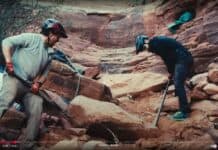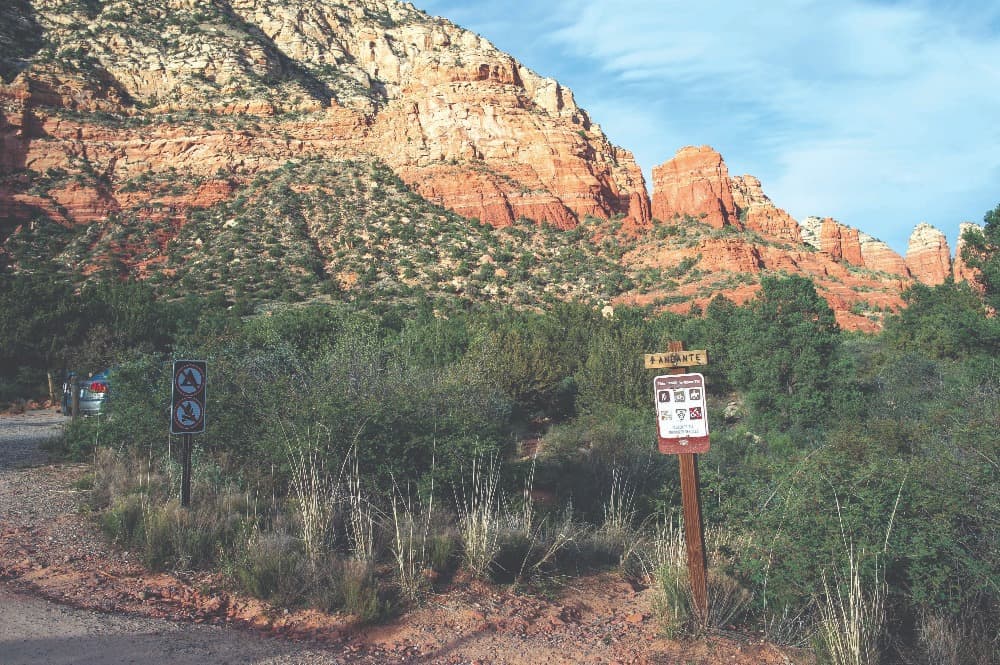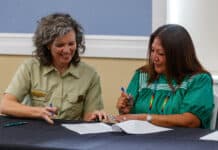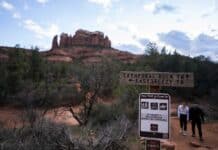Tourist tributes to love, like Disney star Vanessa Hudgens’ unwelcomed contribution in 2016, and etchings memorializing a person or group’s visitation constitute the majority of the red rock-related vandalism that the Red Rock Ranger District deals with. In mid-October to early November, however, the U.S. Forest Service saw an uptick in vandalism, with the bulk of that activity coming in the form of brush-painted obscenities — coherent phrases, not just a word or two — and a racist symbol appearing multiple times on different trails.
Though the obscene phrases and the recurring symbol may have shared a similar time frame of occurrence, USFS Law Enforcement Officer Mike O’Neil said that the RRRD does not have cause to believe they are related acts of vandalism.
Within the span of roughly three weeks, USFS authorities noted four separate appearances of the symbol.
The most recent one was discovered on Bell Rock, and while the Forest Service can’t be sure as to the exact time of its creation, they received the first report of it on Nov. 2.
A teacher from California was hiking up past the first bench and noticed something odd on the rock wall behind a tree.
The initial appearance of the symbol was on Doe Mountain several weeks prior.
Graffiti Removal
Jerry Piepiora, who heads the Friends of the Forest Graffiti Removal Team, said that its size and placement enabled it to be seen from the road.
Piepiora said that the next two were both found at Secret Slickrock, one after the other.
“Because of the subject matter [of the symbol], it therefore can be perceived as a visceral attack on some of the members of our community,” said O’Neil, who was careful not to divulge too much information about how he and others are conducting their criminal investigation.
“We are trying not to show our hand,” he said.
O’Neil did, however, reiterate the importance of the “see something, say something” mantra and asked for the public’s help in ensuring that reports are as thorough and data-filled as possible.
“Community members have things we don’t. If you walk your dog on the same trail every day, you probably see the same people and notice the same behaviors,” O’Neil said. “We can’t always be on the ground like that.”
In addition to high-quality photos, O’Neil said that people who discover acts of vandalism will be asked to provide Forest Service authorities with their full location data as recorded on their GPS apps.
Incidents can be reported at the fs.usda.gov website.
While the RRRD’s investigative work heats up, the FOF Graffiti Removal Team’s job is already done; all aforementioned obscenities and symbols were washed from the rocks almost immediately after being reported.
In this case, it was a grueling process that involved scrubbing the rocks with small wire brushes.
“We don’t have the luxury of 1,200-psi water pressure with a generator hooked up like people who wash buildings do,” said Piepiora, who then complimented the other volunteers for efforts that often go unrecognized.
Piepiora and members of the team hiked up the trails with 10 to 12 gallons of water secured in yellow bladder pump bags that be could carried like a backpack. The removal necessitated multiple trips up and down the trails.
Since the obscenities and the recurring symbol were painted with wide brush strokes, it took the crew hours to clean the rocks.
Piepiora said that after the scrubbing and washing, red dirt is spread over the area, acting like a geological Band-Aid of sorts. After even minor precipitation, this surface layer of dirt washes off, leaving no visible trace of there ever having been an unnatural disturbance.
Illegal Tour Guides
As if the wave of red rock defamation wasn’t enough headache for the USFS, it coincided with a considerable increase in illegal tour guiding and outfitting.
Recreational Special Uses Permit Administrator Mark Goshorn said that in recent months, unpermitted guides have been popping up on social media and commercial platforms — whether in promoting a future hike on Facebook, via references on Yelp, or even in favorable reviews on TripAdvisor.
These guides, either unaware of or unconcerned with USFS rules, take visitors — sometimes in groups as large as 20 — out onto Sedona’s numerous trails and incur unnecessary risks.
Many of the illegal tours have also been spotted by permitted guides while out on the trails; a condition of the USFS permits is that recipients are obliged to report any illegal guiding or otherwise suspicious activity they may encounter.
Goshorn said that metaphysically-themed tours were responsible for the majority of the recent illegal activity, often being led by individuals who operate under eccentric names and market their services in gift shops around town.
Goshorn stressed that while the Forest Service takes no issue with spiritually-focused tours, it has a duty to crack down on all unpermitted, for-profit tours.
Goshorn said he believes people are entitled to enjoy nature however they see fit so long as they obey guidelines, and that metaphysical tours are a unique part of RRRD trail management.
“I don’t know of any other forest or ranger districts that have metaphysical guides that are out there talking about vortexes and meditation.”
On the Red Rock Ranger District’s official listing of permitted guides and outfitters, which can be found at fs.usda.gov/coconino under the Passes and Permit tabs, there are eight permitted companies that offer metaphysical services.
USFS Says Illegal Tours Place Clients at Risk
Unpermitted tours are full of unknowns that often make Arizona Department of Public Safety employees and conservationists alike anxious, as the potential for disaster drastically multiplies.
“[Permitted guides] can only stay on the trails. If they see an archaeological site across the way, they pull the binoculars out. If I’m working for myself in an unpermitted fashion, what’s to stop me from taking you right to the site?” Goshorn said.
“This is also where we are starting to see our archaeological sites become vandalized, either with graffiti or removal of artifacts.”
One of the RRRD’s primary concerns is that these tour guides may be leading visitors into unsafe areas, like the summit of Bell Rock.
“We don’t know if they have any type of CPR training, we don’t know if they have first-aid kits,” he said.
Tour Permit Process
The interconnected safety of humans and the fragile desert ecosystem is the reason the permit system’s exists, he said.
The USFS process of issuing permits is regulated by trail usage surveys. Basic usage studies involve employees hitting trails and noting the amount of human encounters per minute, per 10 minutes, per half-hour and so on.
Studies aimed at discovering whether a specific type of trail usage is causing geological, biological or archaeological harm to a given area are far more complex in design.
Any permit applicant requesting usage of a specific trail will either be denied or approved conditionally.
After discerning what degree of total traffic a trail can sustain, Goshorn said that the Forest Service then issues permits with the goal of creating a fair split between private and public use. All permittees are given limits on the total number of persons allowed per group, number of visitations per day and what time of day those visits can occur — factors that vary trail to trail.
Little more than a month ago, two compliance officers were hired under Goshorn to walk the trails and drive the surrounding roads.
Goshorn said that the enforcers, who offer a much-needed ground presence, approach suspicious trail guides and ask them a series of questions. Based on those interactions, individuals deemed to be in violation of the permit system could receive anything from a verbal warning, to a ticket of up to $500 — even a ticket with a mandated appearance in court.
Repeat offenders can be banned from the forest altogether as trespassers.
“This is an education thing, you want to try and educate them. We’re looking for behavioral change, we’re not trying to get the fines, we’re not trying to just write tickets, we want behavioral change,” Goshorn said. “They can come to me, and there is a chance that I can issue them a temporary permit to do it legally.”
The increase in illegal guiding has come on the tail end of a restructuring period in the Forest Service when the permits division was rebuilt from the ground-up, with Goshorn as administrator.
Now, with a reinforced staff, the permits division aims to spread the word about the consequences of illegal touring guiding, as well as shift perceptions about the RRRD permit process. He identified two of the most prevalent myths surrounding permits:
- Permit costs are unnecessary: According to Goshorn, 95 percent of all the revenue the RRRD generates through permits stays inside the Coconino National Forest. The money goes toward staffing, resources for law enforcement officers, facilities upkeep [i.e. toilet paper and bathroom maintenance] and trail maintenance.
- It’s impossible to get a permit: “A lot of people think that they are hard to get and that we just like to say ‘no,’” Goshorn said. Typically, the RRRD will put out what is called a prospectus, which announces that a certain type of trail usage — hiking, biking, or even rock climbing — has permits available and outlines what the RRRD is looking for in successful permit applicants. These applications are then rated by a panel of USFS employees outside of the district, with the qualifiers undergoing assessment by biologists, archaeologists and other USFS experts whose input on permitting is mandated by the National Environmental Policy Act of 1970. Finally, permits are granted to businesses conditionally.





















